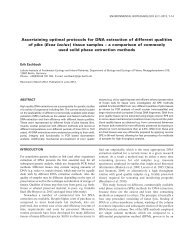18 ENVIRONMENTAL BIOTECHNOLOGY 8 (1) 2012biorefinery that is erected locally may materialize and actualizethe idea <strong>of</strong> prosumption and boost local business initiative.Furthermore, similarly to the petrochemically refined productsthat are estimated to be more than two thousand in number, thepotential <strong>of</strong> biorefined products is assumed to be as large andprospective. Finally the economic effect <strong>of</strong> biorefinery-based<strong>production</strong> will always be the resultant <strong>of</strong> values <strong>of</strong> a variety <strong>of</strong>products produced by means <strong>of</strong> processing biomass, althoughthe objective <strong>of</strong> the biorefinery and its operations will be tomaximize bi<strong>of</strong>uel <strong>production</strong> capacity. Succinic acid, fumaricacid and maleate acid, 2,5-furandicarboxylic acid, 3-hydroxypropionic acid, aspartic acid, glucaric acid, glutamicacid, itaconic acid, levulinic acid, 3-hydroxybutyrolactone acid,glycerol, sorbitol, xylitol/arabitol are referred to as the mostvaluable chemical precursors that determine the added value <strong>of</strong>the biorefinery and that result <strong>from</strong> very few products that arefinely refined (ranked by the US Department <strong>of</strong> Energy 2004).Due to several functional groups capable <strong>of</strong> reacting on and on,each <strong>of</strong> the aforementioned chemical compounds is the inputone for another range <strong>of</strong> semi-products (precursors) and newproducts that are successively developed.Depending on the type <strong>of</strong> biomass, biorefinery-basedprocesses result in a variety <strong>of</strong> bi<strong>of</strong>uels. Production <strong>of</strong> ethanoland oil crops for the purpose <strong>of</strong> 1 st generation fuel involvesthe major crop – grains, potato tubers, oil seeds, etc. Theremaining part <strong>of</strong> biological crop (e.g. straw, chaff, haulm,etc.) is relatively inefficient for agricultural purposes(outdoor burning, ploughing, bedding, etc.) or when used ashard fuel burnt in biomass boilers. In the biorefinery thewhole biological crop can be used up in the form <strong>of</strong> the highlylignified agricultural waste <strong>of</strong> any crop origin but most <strong>of</strong> allin the form <strong>of</strong> the biomass originating <strong>from</strong> dedicated<strong>lignocellulose</strong> crops that do not compete with crops grownfor food, fodder <strong>production</strong> and industrial purposes. Globallythe percentage share <strong>of</strong> <strong>lignocellulose</strong> biomass accounts for90% <strong>of</strong> overall variety <strong>of</strong> biomass and <strong>from</strong> the <strong>production</strong>point <strong>of</strong> view approximately 8-20·10 9 (5-10%) tons <strong>of</strong> primarybiomass representing the estimated potential <strong>of</strong> 200·10 9 tons<strong>of</strong> annual <strong>production</strong> will determine the potential <strong>of</strong> biomassto be used (Lin and Tanaka 2006).Parallely with development <strong>of</strong> innovative technologies <strong>of</strong>bi<strong>of</strong>uel <strong>production</strong> in the biorefinery (research anddevelopment area, industry), the agricultural sector willregularly adjust the development strategy by means <strong>of</strong>adapting itself to the changes in the bi<strong>of</strong>uel market, that arise<strong>from</strong> the technological development, and taking into accountthe economic factors closely related to global conditionalities.The research conducted by Nonhebel (2005) proves thatagricultural crops-based biomass has the potential to satisfythe requirement for natural resources for the purpose <strong>of</strong>motor vehicle fuel, food, fodder, and fibre under thecondition that an essential progress is accomplished inbiomass conversion technologies and the agricultural landuse is rearranged with the net land area remainingunchanged. On the grounds <strong>of</strong> the environmental costbenefitanalysis <strong>of</strong> the biomass <strong>production</strong> for the purpose <strong>of</strong>motor vehicle fuel, similar conclusions are represented byHill (2007) who underlines that effective land use inaccordance with social expectations will be particularlyimportant in the face <strong>of</strong> the rising demand for food andenergy in consecutive decades.According to our own research (Gołaszewski and Stolarski,unpublished data), in Poland at least 15% <strong>of</strong> agricultural land<strong>of</strong> approximately 2 million hectares in area used respectivelyand proportionally for <strong>production</strong> <strong>of</strong> oil, sugar and starch and<strong>lignocellulose</strong>s can be allocated to the biorefinery purposes. Ifthe energy crops area is regularly increased and 2 nd generationbi<strong>of</strong>uel <strong>production</strong> technology is developed and adapted, itwould be only the agricultural sector solely that could fulfilthe commitment thresholds <strong>of</strong> Poland by 2020 in respect <strong>of</strong>7.5% share <strong>of</strong> bi<strong>of</strong>uel in the fuel market, 20% share <strong>of</strong> energy<strong>from</strong> renewable sources and 20% reduction <strong>of</strong> CO 2 emission(85-90% by 2050 as compared to 1990). In many othercountries parallel estimates are higher. In Great Britain theland use potential for power generation purposes is estimatedto equal to 20% (Cookson 2007). In the USA the land usepotential that is capable <strong>of</strong> sustainable biomass <strong>production</strong> forpower generation purposes is estimated to be sufficient toreplace 30% or more <strong>of</strong> the current consumption <strong>of</strong>petrochemical fuel (Perlak et al. 2008).The major determinants for the agricultural bi<strong>of</strong>uelmarket development should cover:• The change in the relation between the costs <strong>of</strong> producing1 st and 2 nd generation bi<strong>of</strong>uels that are 30% higher for 2 ndgeneration bi<strong>of</strong>uel costs inter alia due to new biologicaldiversity and effective bi<strong>of</strong>uel <strong>production</strong> technologies aswell as new support forms for 2 nd generation fuel market.• Higher use efficiency <strong>of</strong> <strong>production</strong> potential <strong>of</strong>agricultural land including dedicated <strong>lignocellulose</strong> crops,first <strong>of</strong> all on the excluded land (idle land, fallow) ormarginal land <strong>of</strong> low crop potential, as well as maximizinguse <strong>of</strong> biological crops.• The change in the import policy and fiscal policy forbi<strong>of</strong>uel including the policy opening the market for<strong>bioethanol</strong>, taking into consideration the relation betweenthe bi<strong>of</strong>uel prices and fossil fuel prices (the price for crudeoil in excess <strong>of</strong> EUR 50 per barrel increases competitiveness<strong>of</strong> bi<strong>of</strong>uel).The need for development <strong>of</strong> the technology <strong>of</strong> producingbi<strong>of</strong>uel <strong>from</strong> agricultural biomass is obvious but at the sametime there are postulates posted against bi<strong>of</strong>uel, which causesthe related social perception to be pejorative to a greatextent. One should not challenge scientific pro<strong>of</strong> <strong>of</strong> possibleadverse impact <strong>of</strong> bi<strong>of</strong>uel <strong>production</strong> upon naturalenvironment, respecting the need for rational action thataddresses both positive aspects and consequences resulting<strong>from</strong> the future-oriented biomass used to a greater extentthan nowadays (Gołaszewski 2009a). Table 1 presents morefrequent postulates that challenge the rightfulness <strong>of</strong>developing bi<strong>of</strong>uel technologies and objective argumentsserving the grounds for purposefulness <strong>of</strong> bi<strong>of</strong>uel <strong>production</strong>development.
Gołaszewski et al. Bioethanol <strong>from</strong> <strong>lignocellulose</strong> 19Table 1. Bi<strong>of</strong>uel <strong>production</strong> postulates and facts.PostulatesProduction <strong>of</strong> bi<strong>of</strong>uel <strong>from</strong>resources that are traditionallyused for food and fodder<strong>production</strong> is competitive inrelation to fodder and food<strong>production</strong>FactsOutstanding <strong>production</strong> potential in marginal or excluded landOutstanding biological and energetic potential <strong>of</strong> <strong>lignocellulose</strong> cropsWaste that has low pr<strong>of</strong>ile may be used as waste resource <strong>of</strong> low value: crop residues,dedicated crops, agricultural and food industry waste and industrial waste, paper waste,forest waste, herb waste and lignified waste <strong>of</strong> agricultural or horticultural originBi<strong>of</strong>uels cause food prices to riseIt is a fact that current prices <strong>of</strong> grains are 3-6% higher than the prices in 2005 but thefollowing must be also taken into account:• Crude oil prices fluctuation• New dietary trends and higher living standards in the countries with high populationgrowth rate (Asian countries and South America) – pressure and competition in thefood <strong>production</strong> marketBi<strong>of</strong>uels are not real option forpetrochemical fuelThe only rational way <strong>of</strong> gaining independence <strong>from</strong> crude oil nowFuel that is locally produced may guarantee continuity <strong>of</strong> <strong>production</strong> contributing toimprovement <strong>of</strong> local energy safety, energy independenceDiversification factor for fuel supplyBi<strong>of</strong>uels contribute toreduction <strong>of</strong> greenhouse effectto a little extentHigh potential <strong>of</strong> reducing emission <strong>of</strong> greenhouse gases depends on energy resourcesand bi<strong>of</strong>uel conversion technologyTheoretically unlimited biomass resources that may be used for power generationpurposesBi<strong>of</strong>uel <strong>production</strong> limitsbiological diversityWider spectrum <strong>of</strong> cropsInfertile land may be usedAgriculture pr<strong>of</strong>itability may be increasedBiomass <strong>production</strong> capital expenditures (crops, means<strong>of</strong> <strong>production</strong>), biomass transportation and the verybi<strong>of</strong>uel <strong>production</strong> process and distribution are key issuesin respect <strong>of</strong> prospective economic and environmentalbenefits arising <strong>from</strong> bi<strong>of</strong>uel <strong>production</strong>. Within theenergetic balance, the power capital expenditures for<strong>production</strong> purposes may be in excess <strong>of</strong> the calorific value<strong>of</strong> bi<strong>of</strong>uel that is produced. Under the current marketconditions, when the cost <strong>of</strong> biomass and its conversioninto monosaccharides is high, the energy balance isgenerally negative in the case <strong>of</strong> <strong>production</strong> <strong>of</strong> 1 stgeneration bi<strong>of</strong>uel, having taken into account theenvironmental impact (<strong>bioethanol</strong> obtained <strong>from</strong> sugarcane is the exception). One <strong>of</strong> the indicators that enable usto compare the <strong>production</strong> <strong>of</strong> 1 st and 2 nd generationbi<strong>of</strong>uel <strong>from</strong> the energy and economic point <strong>of</strong> view isFER – Fossil Energy (Replacement) Ratio that is thequotient <strong>of</strong> bi<strong>of</strong>uel energy units supplied to a final user inrelation to fossil fuel energy units used for <strong>production</strong> <strong>of</strong>bi<strong>of</strong>uel unit (Dale 2007; Sheehan et al. 2004). This meansthat the higher the FER is for bi<strong>of</strong>uel <strong>production</strong>, thehigher value <strong>of</strong> this bi<strong>of</strong>uel as fossil fuel substitute is. Forinstance, for petrol FER=0.8, which means that<strong>production</strong> <strong>of</strong> fuel unit takes 1.25 <strong>of</strong> fossil fuel unit,<strong>bioethanol</strong> made <strong>from</strong> corn FER=1.4, wheat FER=1.2,potato FER=1, sugar cane FER=9, <strong>lignocellulose</strong><strong>bioethanol</strong> FER represent values in the wide range <strong>of</strong> 5-10depending on the type <strong>of</strong> resource (World EconomicOutlook, October 2007). Harrow (2008), comparing thecost <strong>of</strong> fossil fuel (crude oil, coal, natural gas) whenproducing motor vehicle fuel, in terms <strong>of</strong> British ThermalUnit (BTU – 1.055kJ), reports that for petrol it stands at1.23, for <strong>bioethanol</strong> made <strong>from</strong> corn 0.74, and <strong>bioethanol</strong>made <strong>from</strong> cellulose


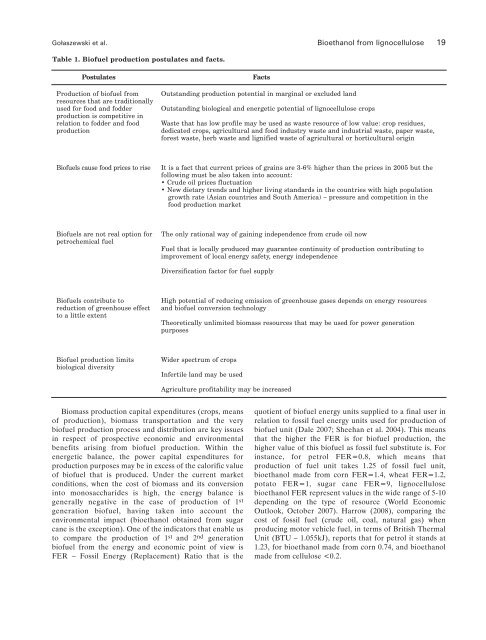
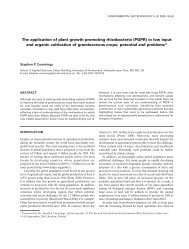
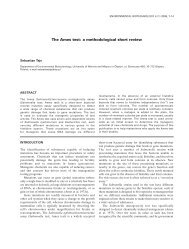
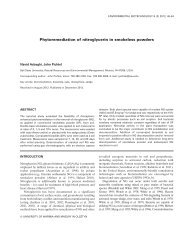


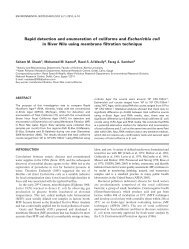
![Genotoxicity of cyclopentha[c]phenanthrene and its two derivatives ...](https://img.yumpu.com/31321772/1/190x249/genotoxicity-of-cyclopenthacphenanthrene-and-its-two-derivatives-.jpg?quality=85)
